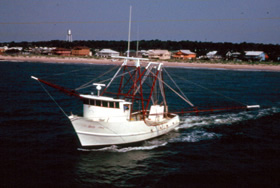Legislation and Permit Evaluations
 Congress
passed the Endangered Species Act (ESA) in 1973. Section 6 of the
ESA provides for funding to the states through Cooperative Agreements.
States must show they have an “adequate and active” program
for the conservation of endangered and threatened species. South
Carolina was among the first group of states to sign a Section 6
Cooperative Agreement in 1976 with the U.S. Fish and Wildlife Service
(USFWS). South Carolina also was the first state to sign a Section
6 Cooperative Agreement with the National Marine Fisheries Service
(NMFS) in 1984.
The
two federal agencies with authority over sea turtles divided their
jurisdiction. USFWS has jurisdiction when sea turtles are on the
beach and the NMFS has jurisdiction when sea turtles are in the water.
South Carolina receives Section 6 grant-in-aid funding from both
agencies each year to carry out research, management, monitoring,
and education activities for the conservation of sea turtles. South
Carolina Department of Natural Resources (SCDNR) formerly the Department
of Wildlife and Marine Resources, passed the Nongame and Endangered
Species Conservation Act in 1976. It affords protection of state
listed endangered and threatened species. The state act is similar
to the federal ESA. All federally listed species occurring in South
Carolina appear on the list along with state listed species. Permits
are required by our department to “take” any listed species.
Take is authorized only for scientific research and/or education.
Section 6 of the ESA also allows the states to authorize and permit
individuals as “agents of the state”. Once trained by
SCDNR, all volunteers that engage in nest protection or are on the
Sea Turtle Stranding and Salvage Network (STSSN) receive this authorization.
Any
construction project, such as beach nourishment or dredging, is reviewed
by SCDNR. Recommendations are made to the federal or state agencies
that will be issuing the permits, as to the timing or extent of the
project, in order to avoid negative impacts to sea turtles on the
beach or at sea.
Congress
passed the Endangered Species Act (ESA) in 1973. Section 6 of the
ESA provides for funding to the states through Cooperative Agreements.
States must show they have an “adequate and active” program
for the conservation of endangered and threatened species. South
Carolina was among the first group of states to sign a Section 6
Cooperative Agreement in 1976 with the U.S. Fish and Wildlife Service
(USFWS). South Carolina also was the first state to sign a Section
6 Cooperative Agreement with the National Marine Fisheries Service
(NMFS) in 1984.
The
two federal agencies with authority over sea turtles divided their
jurisdiction. USFWS has jurisdiction when sea turtles are on the
beach and the NMFS has jurisdiction when sea turtles are in the water.
South Carolina receives Section 6 grant-in-aid funding from both
agencies each year to carry out research, management, monitoring,
and education activities for the conservation of sea turtles. South
Carolina Department of Natural Resources (SCDNR) formerly the Department
of Wildlife and Marine Resources, passed the Nongame and Endangered
Species Conservation Act in 1976. It affords protection of state
listed endangered and threatened species. The state act is similar
to the federal ESA. All federally listed species occurring in South
Carolina appear on the list along with state listed species. Permits
are required by our department to “take” any listed species.
Take is authorized only for scientific research and/or education.
Section 6 of the ESA also allows the states to authorize and permit
individuals as “agents of the state”. Once trained by
SCDNR, all volunteers that engage in nest protection or are on the
Sea Turtle Stranding and Salvage Network (STSSN) receive this authorization.
Any
construction project, such as beach nourishment or dredging, is reviewed
by SCDNR. Recommendations are made to the federal or state agencies
that will be issuing the permits, as to the timing or extent of the
project, in order to avoid negative impacts to sea turtles on the
beach or at sea.



